
French postcard in the series Nos artistes dans leur loge, no. 201. Photo: Comoedia.
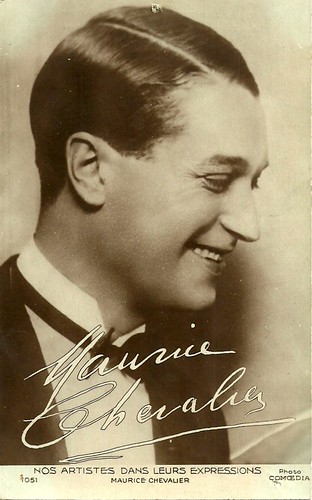
French postcard in the series Nos artistes dans leurs expressions, no. 1051. Photo: Comoedia.

Dutch postcard, no 112. Photo: Paramount.
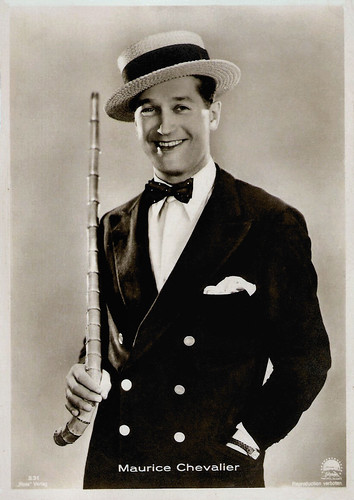
German postcard by Ross Verlag, no. 531. Photo: Paramount.
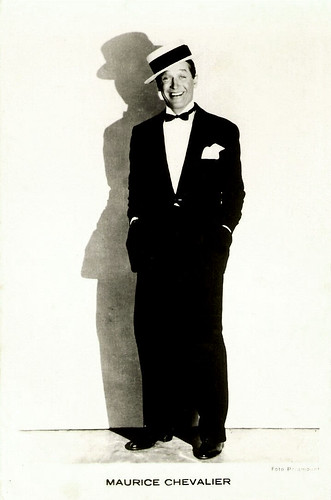
Dutch postcard, ca. 1932. Photo: Paramount.
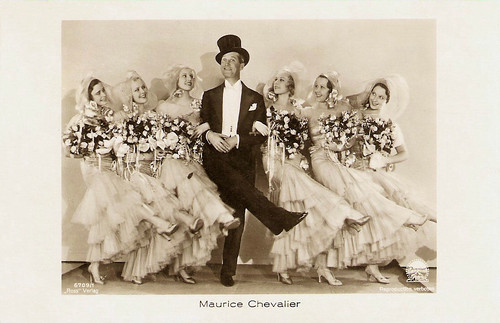
German postcard by Ross Verlag, no. 6709/1, 1931-1932. Photo: Paramount.
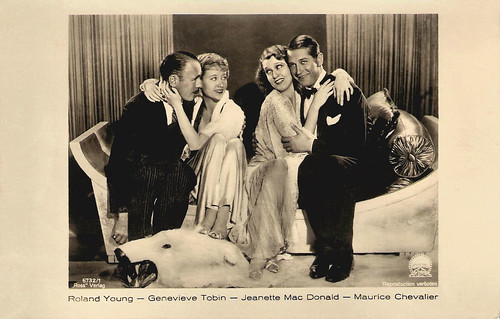
German postcard by Ross Verlag, no. 6732/1, 1931-1932. Photo: Paramount. Publicity still for One Hour with You (Ernst Lubitsch, 1932).
Folies-Bergère
Maurice Auguste Chevalier was born in Paris, France, in 1888, the youngest of nine children. His father was a house painter and his mother, Josephine van den Bosch, was French of Belgian descent. His father did not work steadily. To help out, the 11-year-old Chevalier quit school and worked a number of jobs: a carpenter's apprentice, electrician, printer, and even a doll painter. According to IMDb, he was even a sparring partner to heavyweight boxing champion Georges Carpentier.
After he was injured, he began singing in Paris cafes. In 1901, he was singing, unpaid, at a cafe when a member of the theatre saw him and suggested he would try for a local musical. In the following years, 'Mo' appeared in cafes and music halls as a singer and dancer.
In 1908 he debuted as a comical actor in short films like Trop crédules/Susceptible Youth (Jean Durand, 1908) and he even worked a few times with the celebrated comedian Max Linder in Par habitude/By Habit (Max Linder, 1911) and Une mariée qui se fait attendre/A bride who is waiting (Louis J. Gasnier, 1911).
In 1909, he became the partner of the biggest female star in France, Fréhel. She secured him his first major engagement, as a mimic and a singer in l'Alcazar in Marseille. His act in l'Alcazar was so successful, that he made a triumphant re-arrival in Paris. However, due to her alcoholism and drug addiction, the liaison with Fréhel ended in 1911.
23-year-old Chevalier then started a relationship with 36-year-old Mistinguett at the Folies Bergère, where he was her dance partner. Soon she became his lover as well. He also appeared with her in the short comedies Une bougie récalcitrante/A recalcitrant candle (Georges Monca, 1912) and La valse renversante/The stunning waltz (Georges Monca, 1914).
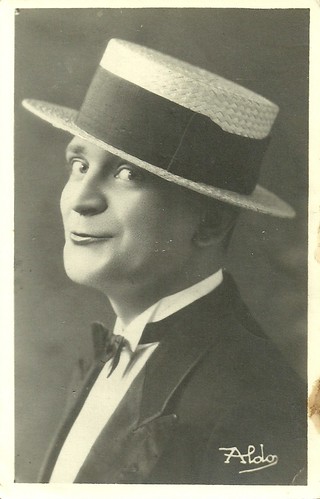
French postcard. Photo Aldo.
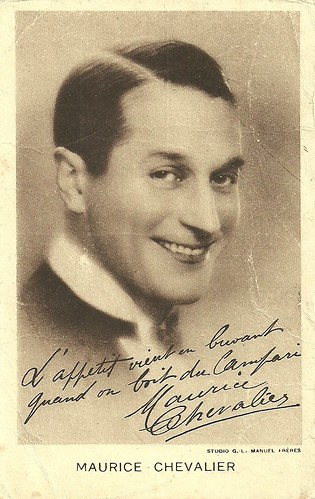
French postcard. Photo: G.L. Manuel Frères. Caption: "L'appetit vient en buvant, quand on boit du Campari."
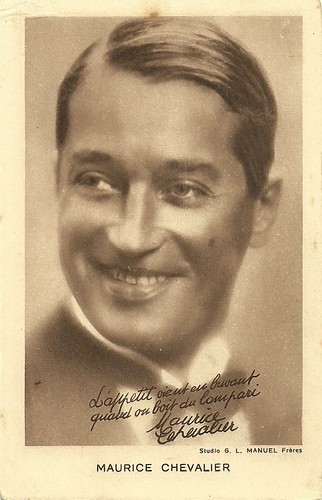
French postcard. Photo Studio Manuel Frères. "L'appetit vient en buvant quand on boit du Campari."
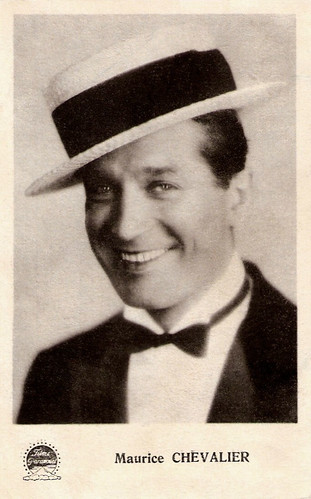
Vintage postcard. Photo: Paramount.
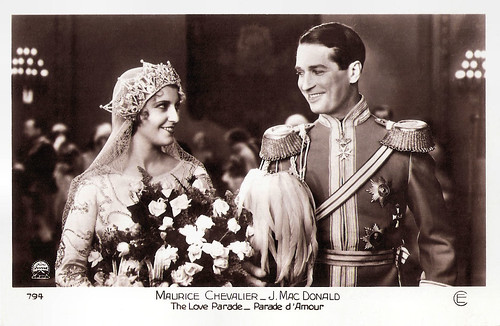
French postcard by Cinémagazine Edition, Paris, no. 794. Photo: Paramount. Publicity still for The Love Parade (Ernst Lubitsch, 1929) with Jeanette MacDonald.
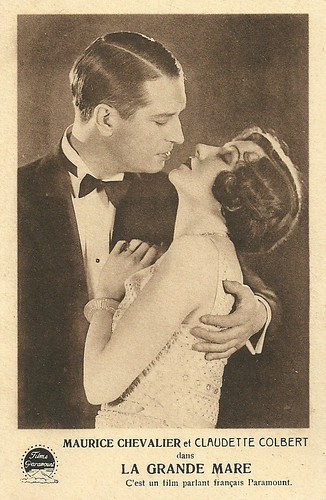
French postcard. Maurice Chevalier and Claudette Colbert In Paramount's romantic comedy La grande mare (Hobart Henley, 1930), the French language version of The Big Pond (Hobart Henley, 1930).
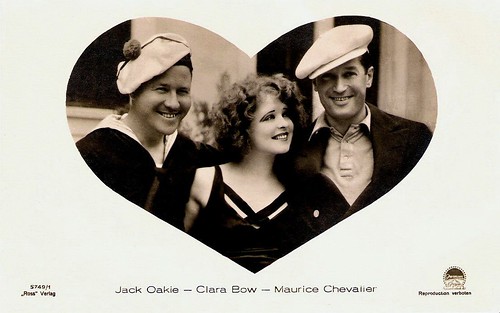
German postcard by Ross Verlag, no. 5749/1, 1930-1931. Photo: Paramount. Publicity still for Paramount on Parade (Dorothy Arzner a.o., 1930) with Jack Oakie and Clara Bow.
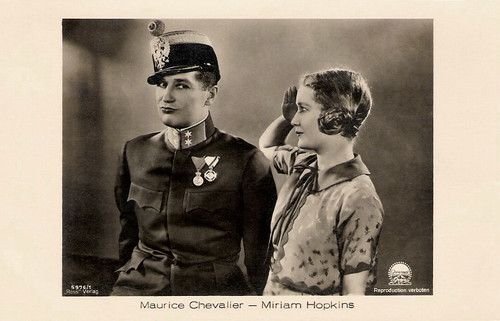
German postcard by Ross Verlag, no. 5976/1, 1930-1931. Photo: Paramount. Publicity still for The Smiling Lieutenant (Ernst Lubitsch, 1931) with Miriam Hopkins.
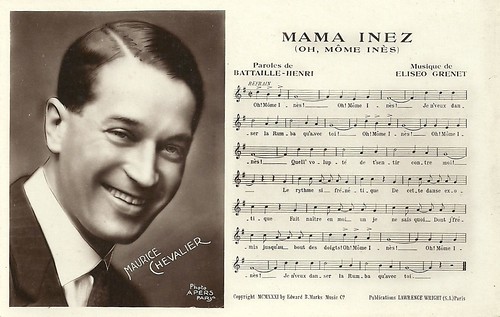
French postcard. Photo: Apers, Paris. Son text of Mama Inez.
German prisoner camp
During World War I, Maurice Chevalier fought in the French army. He was wounded by shrapnel in the back in the first weeks of combat and was taken as a prisoner of war.
During his two years in a German POW camp, he learned English from an English prisoner. According to Wikipedia, he was released in 1916 through the secret intervention of Mistinguett's admirer, King Alfonso XIII of Spain, the only king of a neutral country who related to both the British and German royal families. Later Chevalier was awarded a Croix de Guerre.
In 1917, Chevalier became a star in Le Casino de Paris and played before British soldiers and Americans. After the war, he rose to world fame as a star of music halls.
He discovered jazz and ragtime. He went to London, where he found new success at the Palace Theatre, even though he still sang in French.
Maurce Chevalier started thinking about touring the United States.
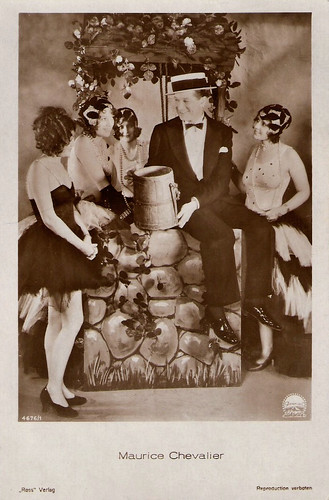
German postcard by Ross Verlag, no. 4676/1, 1929-1930. Photo: Paramount.

French postcard by Edition Ross, no. 5545/2. Photo: Paramount.
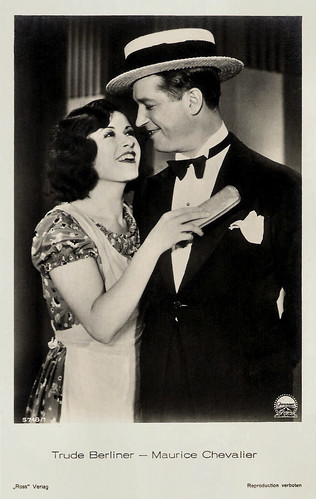
With Trude Berliner. German postcard by Ross Verlag, no. 5748/1, 1930-1931. Photo: Paramount. It is unknown for which film this still was made. Probably it was an alternative language version of a Paramount production, produced at the Paramount Studios near Paris.
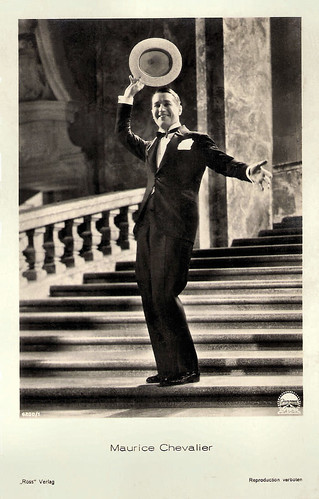
German postcard by Ross Verlag, no. 6200/1, 1931-1932. Photo: Paramount.

German postcard by Ross Verlag, no. 6200/2. Photo: Paramount. Publicity still for The Smiling Lieutenant (Ernst Lubitsch, 1931).
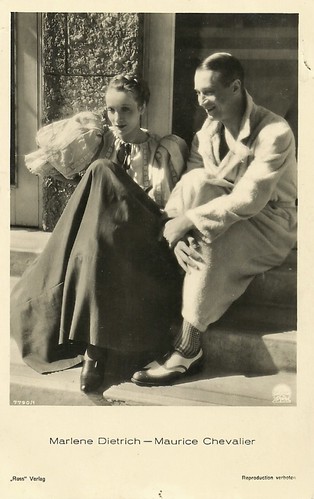
German postcard by Ross Verlag, no. 7790/1. Photo: Paramount. Real-life lovers Marlene Dietrich and Maurice Chevalier at a Paramount set. Dietrich is dressed as the peasant girl from the beginning of The Song of Songs (Rouben Mamoulian, 1933). Chevalier wears what looks like a bathrobe, so he might just have been busy on another Paramount set at the same time. In the film A Bedtime Story (Norman Taurog, 1933) he wears the same shoes.
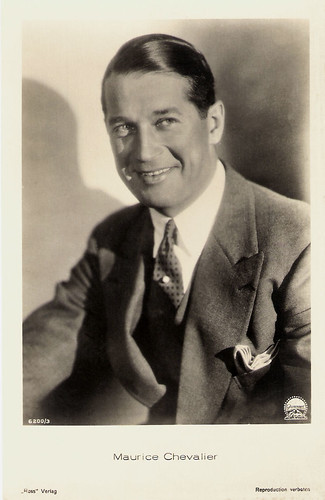
German postcard by Ross Verlag, no. 6200/3, 1931-1932. Photo: Paramount.
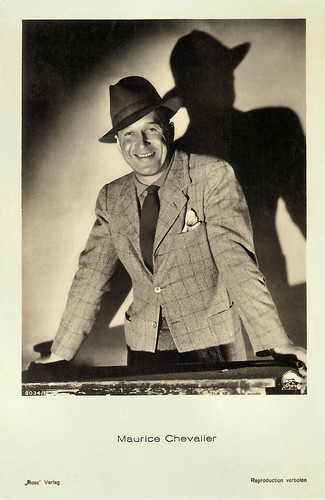
German postcard by Ross Verlag, no. 8034/1, 1933-1934. Photo: Paramount.
Bad boy
After his London success, Maurice Chevalier toured the United States, where he met the American composers George Gershwin and Irving Berlin.
Chevalier returned to Paris and developed an interest in acting. He made a huge impression in the operetta 'Dédé' by Henri Christiné and a libretto by Albert Willemetz.
In addition to his work on the stage, Chevalier began appearing in films like Le Mauvais garçon/Bad Boy (Henri Diamant Berger, 1922) and Jim Bougne, boxeur (Henri Diamant Berger, 1923). In Gonzague (Henri Diamant-Berger, 1922), he co-starred with Marguerite Moreno and Georges Milton.
With the help of George Gershwin and Irving Berlin, he brought Dédé to Broadway in 1922. Douglas Fairbanks offered him star billing in a Hollywood film with Mary Pickford, but Chevalier doubted his own talent for silent films. The films he had made in Paris had largely failed.
In 1922, Chevalier also met Yvonne Vallée, a young dancer, who became his wife in 1927. In these years, he created several songs still known today, such as 'Valentine' (1924).
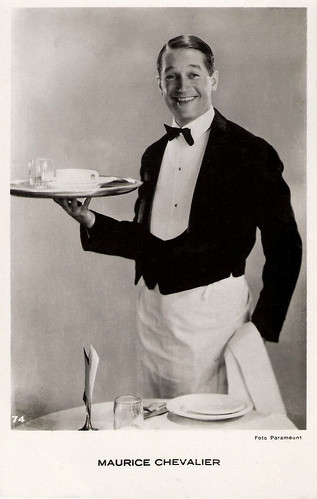
Dutch Postcard, no. 74. Photo: publicity still for Le petit café (1931), a Paramount production directed by the great director Ludwig Berger.

Dutch postcard. Photo: Paramount. Publicity still for Le petit café (Ludwig Berger, 1931).

French or Dutch postcard, no. 1876-33. Probably for Le petit café (Ludwig Berger, 1931). The card was mailed in the Netherlands. The mark top right refers to the Dutch Central Board of Censorship.

Dutch postcard, no. 93, Photo: Paramount. Publicity still for The Playboy of Paris (Ludwig Berger, 1930). Collection: Egbert Barten.

Dutch postcard. Photo: Paramount. Publicity still for The Playboy of Paris (Ludwig Berger, 1930) with Frances Dee.
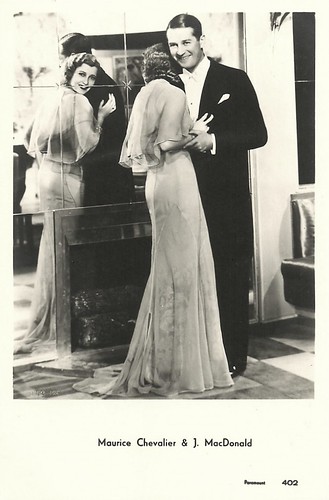
With Jeanette MacDonald. Dutch postcard, no. 402. Photo: Paramount.
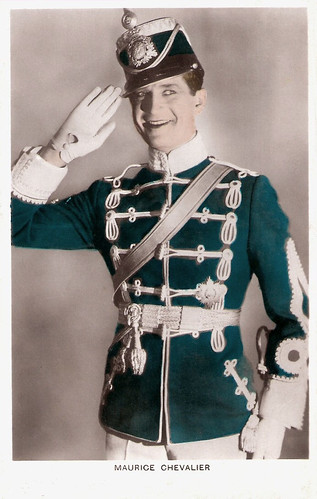
British postcard in the Colourgraph series, London, no. C 64.
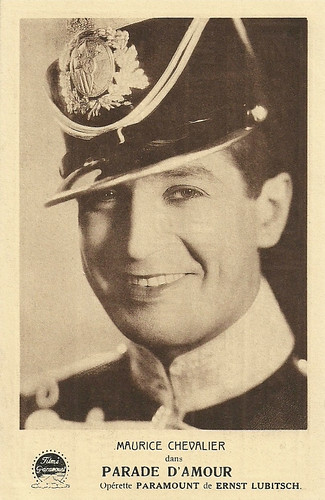
Belgian postcard by Delacre, Charleroi. Photo: Paramount. Publicity still for The Love Parade. Postcard for the Trianon Cinema, Passage de la Bourse, Charleroi, Belgium, where the film was shown from Friday 19 September 1930 on.
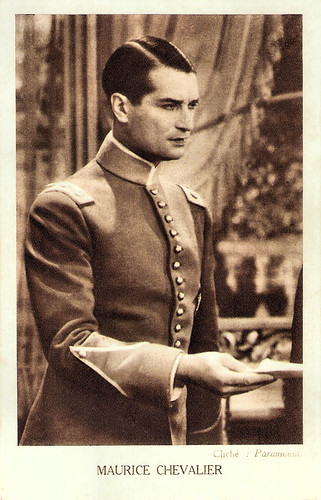
French postcard. Photo: Paramount.
The epitome of French charm and sophistication
When the sound film arrived in 1928, Maurice Chevalier tried his luck in Hollywood.
In 1929 he starred for Paramount Pictures in his first American film musical, Innocents of Paris (Richard Wallace, 1929). In this film, he introduced his theme song, Louise (music by Richard A. Whiting, lyrics by Leo Robin).
He was nominated for Academy Awards for The Love Parade (Ernst Lubitsch, 1929) and The Big Pond (Hobart Henley, 1930). The Big Pond gave Chevalier his first big American hit songs, Livin' In the Sunlight - Lovin' In the Moonlight, plus A New Kind of Love.
Besides The Love Parade, Chevalier and director Ernst Lubitsch made four more hilarious pictures together, the all-star revue film Paramount on Parade (1930), The Smiling Lieutenant (1931) with Claudette Colbert and Miriam Hopkins, the Oscar-nominated One Hour With You (1932) - again with Jeanette MacDonald, and The Merry Widow (1934), the first sound film version of the famous Franz Lehár operetta.
Between 1928 and 1935, Chevalier became recognised as 'the epitome of French charm and sophistication'. His films were instrumental in making film musicals popular again around 1932 and he became the highest-paid star in Hollywood. As the star of radio's long-running Chase and Sanborn Hour, he earned $5000 weekly, a record for radio performers up to that time.
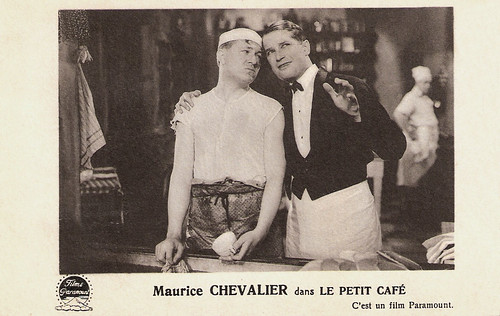
French postcard. Photo: Paramount. Publicity still for Le petit café/Playboy of Paris (Ludwig Berger, 1931). Collection: Egbert Barten.
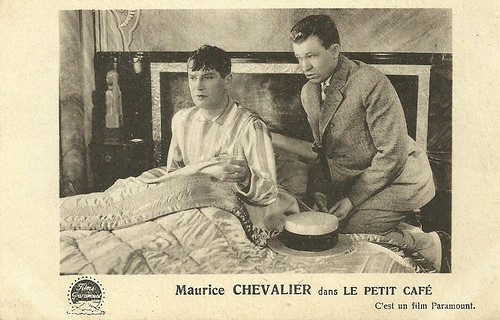
Belgian postcard. Card for the Cine-Palace, Brussels, where the film ran 2-8 October 1931. Le petit café (Ludwig Berger, 1931) was the French language version of Playboy of Paris (Ludwig Berger, 1930).
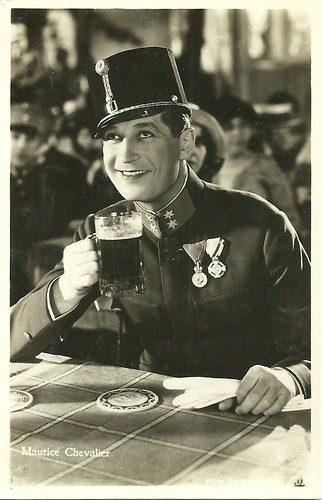
Dutch postcard, no. 302. Photo: Paramount. Maurice Chevalier in the musical comedy The Smiling Lieutenant (Ernst Lubitsch, 1931).
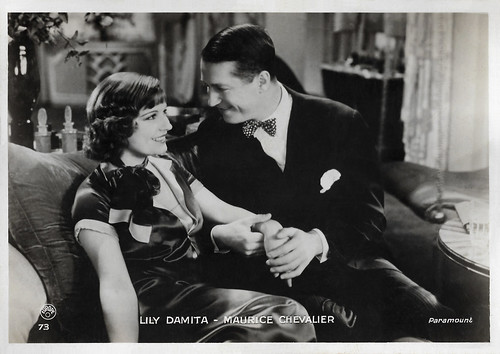
French postcard by Europe, no. 73. Photo: Paramount. With Lily Damita in Une heure près de toi (George Cukor, Ernst Lubitsch, 1932), the French language version of One Hour With You.
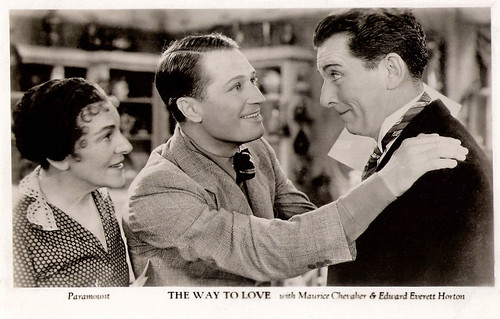
British card. Photo: Paramount. Publicity still for The Way to Love (Norman Taurog, 1933) with Edward Everett Horton.
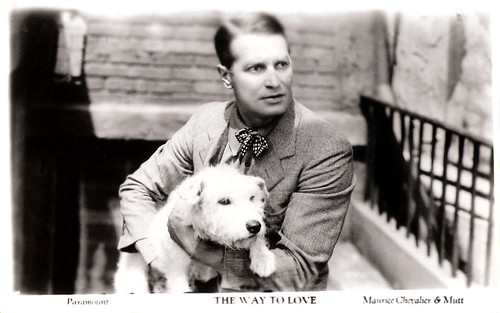
British card. Photo: Paramount. Publicity still for The Way to Love (Norman Taurog, 1933) with Mutt.

British postcard in the Filmshots series by Film Weekly. Photo: Paramount. Publicity still for A Bedtime Story (Norman Taurog, 1933) with Baby Leroy.
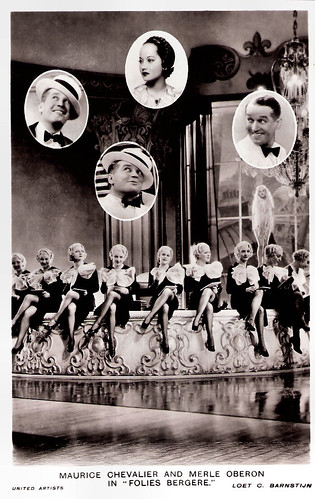
Dutch postcard by Loet C. Barnstijn. Photo: United Artists. Publicity still for Folies Bergère de Paris (Roy Del Ruth, 1935) with Merle Oberon.

French postcard by A.N., Paris, no. 816. Photo: Paramount.
Serial killer
In 1935 Maurice returned to Europe, where he also made several films, like Le vagabond bien-aimé/The Beloved Vagabond (Kurt Bernhardt aka Curtis Bernhardt, 1936), Avec le sourire/With a Smile (Maurice Tourneur, 1936), L'homme du jour/The Man of the Hour (Julien Duvivier, 1937) and Pièges/Snares (Robert Siodmak, 1939) in which he played a serial killer opposite Marie Déa and Pierre Renoir.
In 1937, he married the dancer Nita Raya. He had several stage successes, such as his revue Paris en Joie in the Casino de Paris. A year later, he performed in Amours de Paris. His songs continued to become big hits, such as Prosper (1935), Ma Pomme (1936) and Ça fait d'excellents français (1939). In 1938 he was decorated a Chevalier of the Legion of Honor.
During World War II, Chevalier kept performing for audiences. In 1941, he performed a new revue in the Casino de Paris: Bonjour Paris, which was another success. From 1941 to 1945, he sang the songs composed by Henri Betti with the lyrics of Maurice Vandair as Notre Espoir (1941), La Chanson du Maçon (1941) and La Fête à Neu-Neu (1943). The Nazis asked Chevalier to perform in Berlin and to sing for the collaborating radio station Radio-Paris. He refused, but he did perform in front of war prisoners in Germany at the camp where he was interned in World War I and succeeded in liberating ten people in exchange.
In 1942 he returned to Bocca, near Cannes, but returned to Paris in September. In 1944 when Allied forces freed France, Chevalier was accused of collaborationism. Even though he was acquitted by a French-convened court, the English-speaking press remained hostile and he was refused a visa for several years.
For this, Wikipedia gives another explanation: "In 1944, he had already participated in a Communist demonstration in Paris. He was therefore even less popular in the U.S. during the McCarthyism period; in 1951, he was refused re-entry into the U.S. because he had signed the Stockholm Appeal." This was a petition against nuclear weapons and the U.S. State Department had declared Chevalier "potentially dangerous" to the security of the United States.
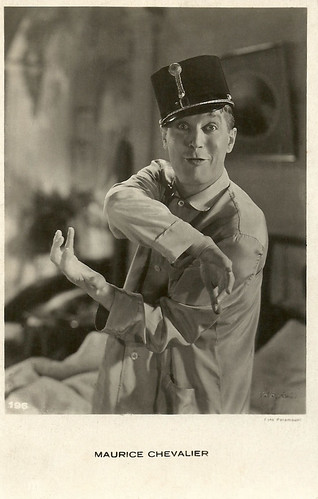
Dutch postcard, no. 196. Photo: Paramount.
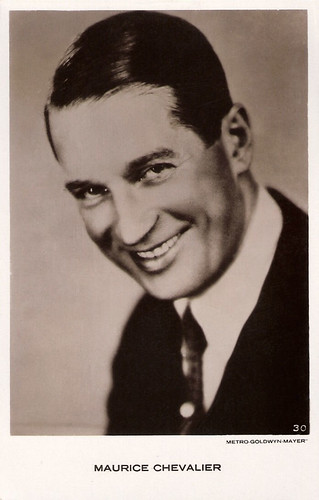
Dutch postcard by JosPe, no. 30, mailed in 1931. Photo: Metro-Goldwyn-Mayer.

Dutch postcard by JosPe, Arnhem, no. 290. In 1932 Maurice Chevalier visited the Dutch cities of Amsterdam, The Hague and Volendam.
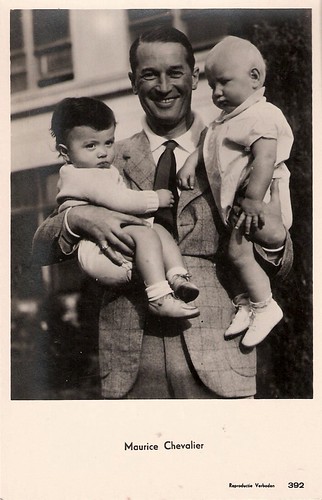
Dutch postcard by JosPe, Arnhem, no. 392

Dutch postcard by JosPe, Arnhem. Photo: Maurice Chevalier in the fisher town of Volendam, The Netherlands. This picture was taken in 1932 when he visited Holland.

Dutch postcard by JosPe, Arnhem. 'Den Haag 21 September 1932' is written on the backside of the postcard. That night Chevalier performed at the Gebouw voor Kunsten en Wetenschappen (Arts & Sciences building) in Den Haag/The Hague, The Netherlands. The day before Chevalier had visited Volendam and Amsterdam and had performed at the still-existing - Amsterdam movie palace Tuschinski Theater.
Gigi
After World War II, Maurice Chevalier was still popular in France. In 1946, he split from Nita Raya and started writing his memoirs, which took many years to complete.
He toured the world with his one-man show and acted in films like Le Silence est d'Or/Silence Is Golden (René Clair, 1946).
In 1952, he bought a large property in Marnes-la-Coquette, near Paris, and named it La Louque, as a homage to his mother's nickname. He started a relationship in 1952 with Janie Michels, a young divorcee with three children.
In the late 1950s, after the McCarthy era abated, he returned to Hollywood. The Billy Wilder film Love in the Afternoon (1957) with Audrey Hepburn and Gary Cooper was his first Hollywood film in more than 20 years.
Chevalier then appeared in the hit musical Gigi (Vincente Minnelli, 1958) with Leslie Caron. Older and grey-headed he sang his signature songs, Thank Heaven for Little Girls, and I Remember it Well, the latter with Hermione Gingold.
The success of Gigi prompted Hollywood to give him an Honorary Academy Award in 1959 for his achievements in entertainment.
In the 1960s, he continued to make a few more films, including the drama Fanny (Joshua Logan, 1961), in which he starred with Leslie Caron and Charles Boyer. This film was an updated version of Marcel Pagnol's Marseilles Trilogy.
In 1965, at 77, Chevalier made another world tour. In 1967 he toured in Latin America, again, the US, Europe, and Canada. The following year, he announced his farewell tour.
In 1970, a few years after his retirement, he sang the title song for Walt Disney's, The AristoCats (Wolfgang Reitherman, 1970). This marked his last contribution to the film industry.
Maurice Chevalier died in Paris, in 1972, aged 83.

German postcard. Photo: IFA. Publicity still for Pièges/Personal Column (Robert Siodmak, 1939) with Marie Déa.

French postcard by Europe, no. 1064. Photo: Paramount.
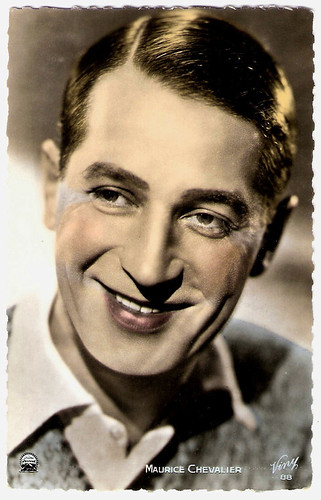
French postcard by Viny, no 88. Photo: Paramount.
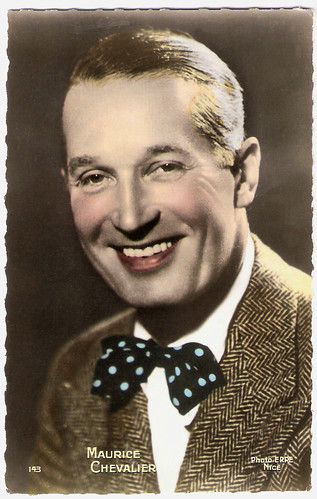
French postcard by Editions P.I., Paris, no. 143. Photo: Erpe, Nice.
Preview clip of The Merry Widow (Ernst Lubitsch, 1934). Source: Warner archive (YouTube).
Trailer for Love in the Afternoon (Billy Wilder, 1957). Source: Rotten Tomatoes Classic Trailers (YouTube).
Trailer for Gigi (Vincente Minnelli, 1958). Source: Warner Bros. (YouTube).
Sources: Volker Boehm (IMDb), AllMovie, Wikipedia and IMDb.
This post was last updated on 22 September 2023.
2 comments:
And I thought I knew a thing or two about Maurice Chevalier...but not all this. A fascinating read. Thank you so much!
Oh yes, I remember him well. :) Well not all of it, but I do remember his later years.
Post a Comment